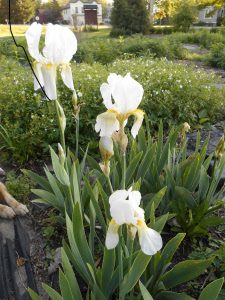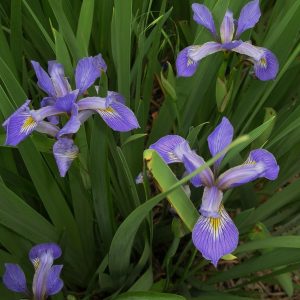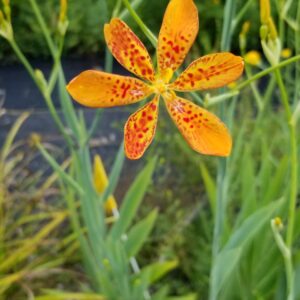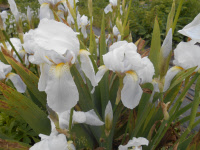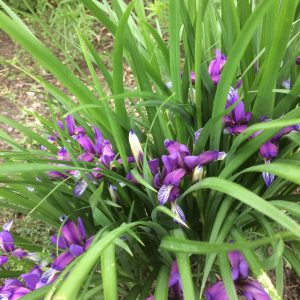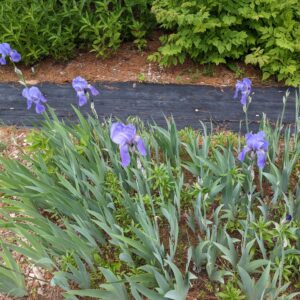Perennials & Biennials
Showing 257–264 of 485 results
-
Iris ‘Polar King’ Z 4-9
Pure white with yellow falls, reblooming iris. Blooms spring and again in fall.
Pure white with yellow falls, reblooming iris. Blooms spring and again in fall.
Size: 34”x8” Vigorous & spreads by rhizomes.
Care: Sun in moist well-drained to well-drained soil. Plant with rhizome tops above soil. In July-August lift & divide every 2 to 3 years; discard mushy rhizomes. In fall cut back foliage to prevent moths from laying eggs of Iris borer.
Wildlife Value: Deer and rabbit resistant.
Awards: American Iris Society Award of MeritIris is named after the Greek goddess who accompanied the souls of women to the Elysian fields by way of the rainbow. Her footprints left flowers the colors of the rainbow. Iris means “eye of heaven.” The iris is the flower of chivalry, having “a sword for its leaf and a lily for its heart.” Ruskin. This hybrid bred by Thomas Donahue of Newton Lower Falls, Massachusetts. He 1st showed it at the Massachusetts Horticultural Society flower show in October of 1931 where it won several awards. Registered in 1939.
-
Iris cristata Crested iris Z 4-8
Lavender, blue or white, short Iris blooming, in May, on this small, shade Iris, make a good shade groundcover
Lavender, blue or white, short Iris blooming, in May, on this small, shade Iris, make a good shade groundcover
Size: 6” x 8" spreader
Care: Part to full shade in moist well-drained to well-drained soil
Native: Maryland to Georgia, west to Missouri
Wildlife Value: Deer and rabbit resistant.Cherokee applied a salve of the pulverized root to ulcers and made an infusion to remedy liver ailments. Collected by Rev. John Banister (1649-1692) who moved to colonial Virginia in 1678. A gunman mistakenly shot and killed him while he collected plants. Grown by Jefferson.
-
Iris domestica syn. Belamcanda chinensis Blackberry lily Z 5-10
Each orange flower covered with dark orange spots on its 5 canoe-shaped petals held aloft by a leafless stem. The flowers turn into round, shiny, black seeds in summer and fall. Only the leaves look like an Iris. (Spoiler alert – despite the common name of lily, this is not a lily.) Taxonomists reclassified this into an Iris in 2005 based on its DNA.
Each orange flower covered with dark orange spots on its 5 canoe-shaped petals held aloft by a leafless stem. The flowers turn into round, shiny, black seeds in summer and fall. Only the leaves look like an Iris. (Spoiler alert – despite the common name of lily, this is not a lily.) Taxonomists reclassified this into an Iris in 2005 based on its DNA.
Size: 18-36” x 10”
Care: sun, moist well drained soil
Native: China and Japan
Wildlife Value: attracts hummingbirds, bees and butterflies. Deer and rabbit resistant.The Blackberry lily was cultivated in China as a medicinal plant as long ago as 120 B.C. Its root of the Blackberry Lily is known as the Chinese herb She-gan. She-gan is listed in the third class of drugs in the ancient Shen Nong Ben Cao Jing. Shen Nong which mentions she-gan in the treatment of laryngea l tumors. (Foster and Yue 1992). Jesuit missionaries collected seeds in China then sent them to Europe by the 1730s. It was cultivated in Linnaeus’ botanical garden in Uppsala Sweden by 1748 and in English gardens by at least 1759. Jefferson grew this at Monticello.
-
Iris florentina Florentine iris, White flag Z 3-9
Sweetly fragrant, tall, icy blue-white iris with pale yellow signal on the fall, flowering in June
Sweetly fragrant, tall, icy blue-white iris with pale yellow signal on the fall, flowering in June
Size: 24-30” x 18-24”
Care: sun in moist well-drained soil. Plant with rhizome tops above soil.
Native: Italy and southern France
Wildlife Value: welcomes bees with easy access to pollenIris is named after the Greek goddess who accompanied the souls of women to the Elysian fields by way of the rainbow. Her footprints left flowers the colors of the rainbow. Iris means “eye of heaven.” The iris is the flower of chivalry, having “a sword for its leaf and a lily for its heart.” Ruskin. At least 2000 years old, this was identified by Dioscorides in De Materica Medica for medicinal use around 70 A.D. English herbalist John Gerard grew it by 1596. Grown in the Eichstätt Garden, the garden of Johann Konrad von Gemmingen, prince bishop of Eichstätt in Bavaria, c. 1600. Grown at America’s 1st botanic garden, Elgin Botanic Garden 1811. Its rhizome is the source of dried orris root. Dig in late summer, peel, chop, dry, age, and then grind into a powder which is a scent fixative for perfumes and potpourris and flavoring for Chianti wine. Orris root has a violet-like aroma. Add powder directly to potpourris. Mix with oil prior to adding to perfumes.
-
Iris graminea Grass-leaved iris, Plum-scented iris Z 4-8
Charming beardless spuria iris of purple styles, violet falls and ivory hafts with purple veins, blooming in June below the top of its grass-like foliage
Charming beardless spuria iris of purple styles, violet falls and ivory hafts with purple veins, blooming in June below the top of its grass-like foliage
Size: 9-16” x 9-16”
Care: sun to part shade in moist well-drained soil
Native: from Spain to Russia & Caucasus in Asia. But now endangered in Czechoslovakia and extinct in Germany.
Wildlife Value: attracts hummingbirds, bees, and butterflies. Deer and rabbit resistant.
Awards: Royal Horticultural Society Award of Garden Merit.Graminea means grass. Common name of Plum-scented for its fruity, plum fragrance. In gardens since at least 1568. Planted at Cambridge Botanic Garden in 1733.
-
Iris missouriensis Western blue flag, Rocky Mountain iris Z 3-8
In spring variegated, violet blue iris flowers - 6 perianth segments, 3 spreading to reflexed falls with a dark yellow-orange stripe down the middle with blue lines on a white background, & 3 purple standards.
In spring variegated, violet blue iris flowers – 6 perianth segments, 3 spreading to reflexed falls with a dark yellow-orange stripe down the middle with blue lines on a white background, & 3 purple standards.
Size: 12-24” x 9-12”
Care: sun to part shade in moist well-drained to moist soil. Divide regularly.
Native: Alberta and British Columbia, from Minnesota to Washington south to California east to New Mexico
Wildlife Value: Deer resistant. Attracts hummingbirds, provides pollen to bees.Named for the Missouri River although ironically Lewis collected it along the Blackfoot River in today’s Montana on July 5, 1806.
Paiute Indians of eastern California and southeastern Oregon made ear drops to remedy earaches with a decoction if the Iris roots. -
Iris pallida Grape iris Z 3-8
Blooms smell exactly like sweet grape soda - violet blue bearded iris in spring
Blooms smell exactly like sweet grape soda – violet blue bearded iris in spring
Size: 10-14” x 8-12”
Care: sun to part shade in moist well-drained soil. In July-August lift & divide every 2 to 3 years; discard mushy rhizomes.
Native: Europe
Wildlife Value: Deer and rabbit resistant.English herbalist John Gerard (1549-1612) called it “the great Floure de-luce of Dalmatia” and praising its “exceedingly sweet” scent, 1597. Grape soda had yet to be created.! Was this the soda’s inspiration? Dried rhizomes used as a fixative to preserve fragrances in powders, perfume, and gin. Peel off outer skin of rhizomes and dry tor up to five years for this.
-
Iris pumila Dwarf iris Z4-8
Natural hybrid created this tiny, purple bearded iris blooming in early spring bearing year-long green-grey sword-shaped leaves. Spreads to form large, tight clumps.
Natural hybrid created this tiny, purple bearded iris blooming in early spring bearing year-long green-grey sword-shaped leaves. Spreads to form large, tight clumps.
Size: 6-8” x spreading.
Care: sun in well-drained to moist well-drained soil
Native: Eastern Europe
Wildlife Value: deer resistantIn gardens before 1753

